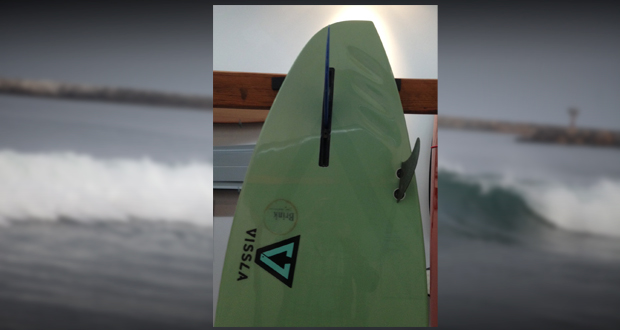San Clemente CA— The latest exhibit at the Surfing Heritage and Culture Center (SHACC) showcases the out-of-the-box thinking of some of the most radical, experimental surfboard builders in the industry. A walk through the exhibit, “What Box? Thinking Outside Traditional Lines of Surfboard Design,” will have you scratching your head and saying to yourself, “could this surfboard really work?”
The exhibit, made possible by a generous donation from John Mazza, Founder of the Mailbu Surfing Museum at Pepperdine, features a quiver of unconventional and even outlandish surf crafts created by Carl Ekstrom, Tom Morey, Donald Brink and Ryan Burch.
According to SHACC Curator and Creative Director, Barry Haun, this is a rare chance to get inside the minds of the mad scientists of surfing and explore the thinking and technology behind these revolutionary surfboard designs.
“Many of the boards in the new exhibit will feature asymmetrical designs. Just the thought of a surfboard that doesn’t have the same curvature on both sides of the stringer boggles the mind,” Haun said. “But when you have more fins on one side of the tail than the other, and fins set with different toe-in angles…things really start to get interesting. And then there are the boards with strange channels carved into the foam…and no fins at all.”
“We’re really stoked to share the unique, and in some cases, futuristic designs of some of surfing’s most unconventional board makers,” said Paul Strauch, Executive Director of SHACC. “It’s going to be really fun and entertaining to listen to some of the discussions, design theories and debates in our showroom about the boards on display.”
Carl Ekstrom patented his asymmetrical surfboard design in 1967. He arrived at the design in the process of trying to find a board that he could surf equally well going frontside and backside. Many of Ekstrom’s more contemporary designs are asymmetrical versions of various fish-style boards. Carl truly believes “there’s no reason to stay symmetrical.”
Tom Morey helped develop Slipcheck in 1965, a surfboard traction spray-on used as an alternative to wax. He is also credited with introducing the first commercially successful removable fin system, called W.A.V.E. Morey is obviously most famous for introducing his namesake, bendable soft-skinned Morey Boogie board in 1973. Shortly thereafter, Morey and California surfer Mike Doyle co-developed the Morey-Doyle soft surfboard.
Ryan Burch is a talented free surfer and surfboard shaper from Encinitas, California. He has experimented with closed-cell foam boards based on Lindsay Lord’s planing hulls and was inspired by Carl Ekstrom to start riding and shaping asymmetrical boards. If you’re skeptical about the performance potential of asymmetrical boards in serious surf, do a quick Google search to locate footage of Ryan carving up some serious bombs in Indo last year. Ryan earned a boost of notoriety by winning the “Young Guns of Shaping” contest at Sacred Craft in 2010.
Another free-thinking shaper, Donald Brink, 34, was born and raised in South Africa. As a teen, he became dedicated student of surfboard building. He started wielding his own planer in 2005 in his early 20s. A big believer in hand shaping, Donald loves to use innovative designs to empower surfers on any size waves. “Asymmetry for me makes for accurate and enjoyable surfing with ease on the smallest of canvases. My boards are stance specific and allow the best experience to be learned both front side and back,” he said.
If you want to see some truly unconventional surfboard designs, make a visit to SHACC before this exhibit closes in mid April, to make room for the museum’s “Trailblazers in Women’s Surfing” exhibit, slated to open on April 25, 2015. SHACC is located at 110 Calle Iglesia, San Clemente, CA 92672. You can also get SHACC’d at www.surfingheritage.org
About SHACC
The Surfing Heritage and Culture Center is a non-profit organization dedicated to preserving and celebrating surfing’s heritage, promoting cultural diversity and education, and collaborating with chartable organizations to make a positive impact in our communities. SHACC also works ensure that surfing is more accurately understood, represented and enjoyed. SHACC is located in San Clemente, California and houses the world’s largest collection of historic photo images and surfboards.



